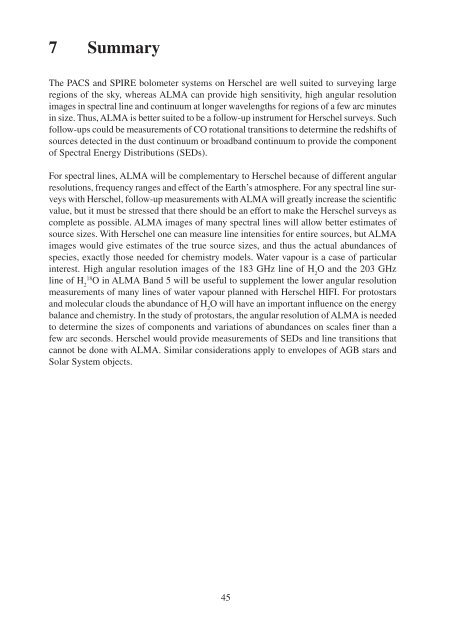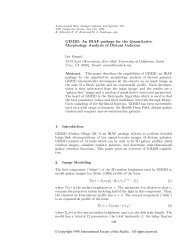4 Comparison of the ALMA and Herschel - ESO
4 Comparison of the ALMA and Herschel - ESO
4 Comparison of the ALMA and Herschel - ESO
Create successful ePaper yourself
Turn your PDF publications into a flip-book with our unique Google optimized e-Paper software.
7 Summary<br />
The PACS <strong>and</strong> SPIRE bolometer systems on <strong>Herschel</strong> are well suited to surveying large<br />
regions <strong>of</strong> <strong>the</strong> sky, whereas <strong>ALMA</strong> can provide high sensitivity, high angular resolution<br />
images in spectral line <strong>and</strong> continuum at longer wavelengths for regions <strong>of</strong> a few arc minutes<br />
in size. Thus, <strong>ALMA</strong> is better suited to be a follow-up instrument for <strong>Herschel</strong> surveys. Such<br />
follow-ups could be measurements <strong>of</strong> CO rotational transitions to determine <strong>the</strong> redshifts <strong>of</strong><br />
sources detected in <strong>the</strong> dust continuum or broadb<strong>and</strong> continuum to provide <strong>the</strong> component<br />
<strong>of</strong> Spectral Energy Distributions (SEDs).<br />
For spectral lines, <strong>ALMA</strong> will be complementary to <strong>Herschel</strong> because <strong>of</strong> different angular<br />
resolutions, frequency ranges <strong>and</strong> effect <strong>of</strong> <strong>the</strong> Earth’s atmosphere. For any spectral line surveys<br />
with <strong>Herschel</strong>, follow-up measurements with <strong>ALMA</strong> will greatly increase <strong>the</strong> scientific<br />
value, but it must be stressed that <strong>the</strong>re should be an effort to make <strong>the</strong> <strong>Herschel</strong> surveys as<br />
complete as possible. <strong>ALMA</strong> images <strong>of</strong> many spectral lines will allow better estimates <strong>of</strong><br />
source sizes. With <strong>Herschel</strong> one can measure line intensities for entire sources, but <strong>ALMA</strong><br />
images would give estimates <strong>of</strong> <strong>the</strong> true source sizes, <strong>and</strong> thus <strong>the</strong> actual abundances <strong>of</strong><br />
species, exactly those needed for chemistry models. Water vapour is a case <strong>of</strong> particular<br />
interest. High angular resolution images <strong>of</strong> <strong>the</strong> 183 GHz line <strong>of</strong> H 2<br />
O <strong>and</strong> <strong>the</strong> 203 GHz<br />
line <strong>of</strong> H 2<br />
18<br />
O in <strong>ALMA</strong> B<strong>and</strong> 5 will be useful to supplement <strong>the</strong> lower angular resolution<br />
measurements <strong>of</strong> many lines <strong>of</strong> water vapour planned with <strong>Herschel</strong> HIFI. For protostars<br />
<strong>and</strong> molecular clouds <strong>the</strong> abundance <strong>of</strong> H 2<br />
O will have an important influence on <strong>the</strong> energy<br />
balance <strong>and</strong> chemistry. In <strong>the</strong> study <strong>of</strong> protostars, <strong>the</strong> angular resolution <strong>of</strong> <strong>ALMA</strong> is needed<br />
to determine <strong>the</strong> sizes <strong>of</strong> components <strong>and</strong> variations <strong>of</strong> abundances on scales finer than a<br />
few arc seconds. <strong>Herschel</strong> would provide measurements <strong>of</strong> SEDs <strong>and</strong> line transitions that<br />
cannot be done with <strong>ALMA</strong>. Similar considerations apply to envelopes <strong>of</strong> AGB stars <strong>and</strong><br />
Solar System objects.<br />
45




